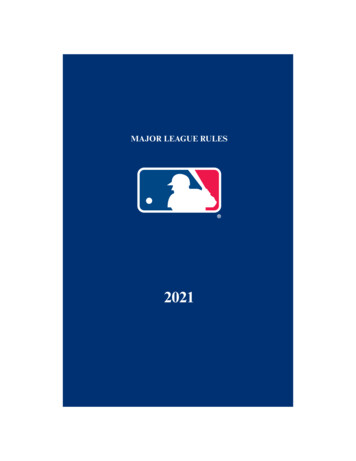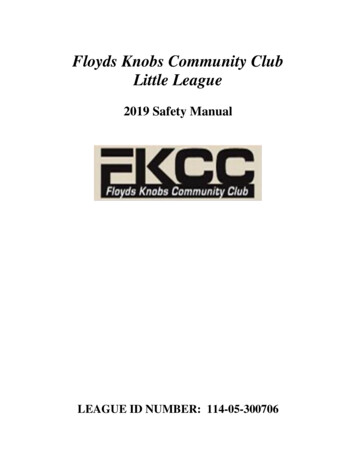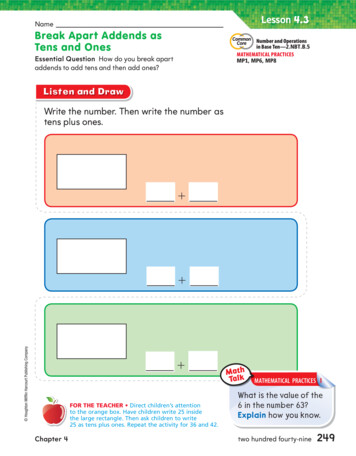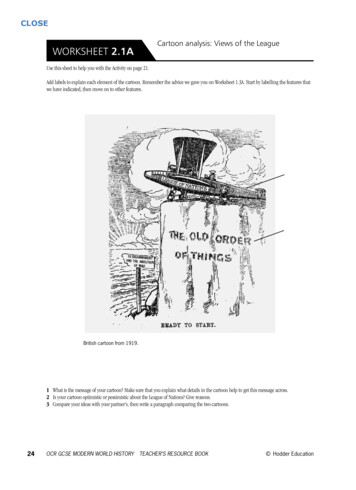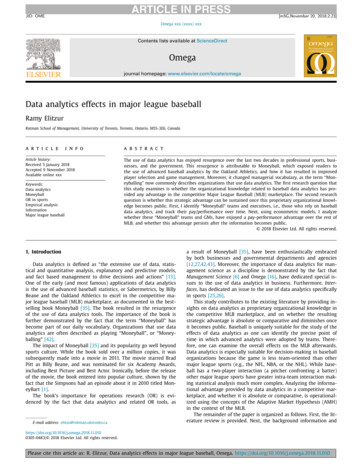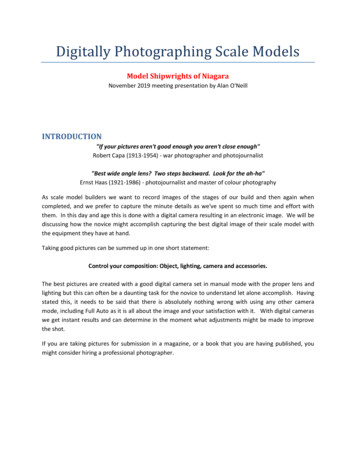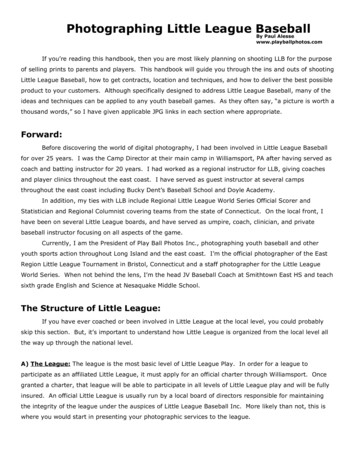
Transcription
Photographing Little League BaseballBy Paul Alessewww.playballphotos.comIf you’re reading this handbook, then you are most likely planning on shooting LLB for the purposeof selling prints to parents and players. This handbook will guide you through the ins and outs of shootingLittle League Baseball, how to get contracts, location and techniques, and how to deliver the best possibleproduct to your customers. Although specifically designed to address Little League Baseball, many of theideas and techniques can be applied to any youth baseball games. As they often say, “a picture is worth athousand words,” so I have given applicable JPG links in each section where appropriate.Forward:Before discovering the world of digital photography, I had been involved in Little League Baseballfor over 25 years. I was the Camp Director at their main camp in Williamsport, PA after having served ascoach and batting instructor for 20 years. I had worked as a regional instructor for LLB, giving coachesand player clinics throughout the east coast. I have served as guest instructor at several campsthroughout the east coast including Bucky Dent’s Baseball School and Doyle Academy.In addition, my ties with LLB include Regional Little League World Series Official Scorer andStatistician and Regional Columnist covering teams from the state of Connecticut. On the local front, Ihave been on several Little League boards, and have served as umpire, coach, clinician, and privatebaseball instructor focusing on all aspects of the game.Currently, I am the President of Play Ball Photos Inc., photographing youth baseball and otheryouth sports action throughout Long Island and the east coast. I’m the official photographer of the EastRegion Little League Tournament in Bristol, Connecticut and a staff photographer for the Little LeagueWorld Series. When not behind the lens, I’m the head JV Baseball Coach at Smithtown East HS and teachsixth grade English and Science at Nesaquake Middle School.The Structure of Little League:If you have ever coached or been involved in Little League at the local level, you could probablyskip this section. But, it’s important to understand how Little League is organized from the local level allthe way up through the national level.A) The League: The league is the most basic level of Little League Play. In order for a league toparticipate as an affiliated Little League, it must apply for an official charter through Williamsport. Oncegranted a charter, that league will be able to participate in all levels of Little League play and will be fullyinsured. An official Little League is usually run by a local board of directors responsible for maintainingthe integrity of the league under the auspices of Little League Baseball Inc. More likely than not, this iswhere you would start in presenting your photographic services to the league.
B) The District: The district is comprised of many leagues within an area. Smaller states have fewerdistricts, while larger states have many districts. New York and California have over 35 districts. Eachdistrict is governed by a District Administrator or “DA”.C) The State: Depending on the size of the state, some states divide their states into sections. Here inNY, the state is divided into 4 sections.D) The Region: States are grouped together into Regions. Here in the east, there are two majorRegions, the New England Region which contains six states and the Mid-Atlantic Region which containsfive states. There are currently 16 Little League Regions across the globe, 8 USA regions and 8International regions.E) The World Series: The Little League World Series is held every year at the end of August. The 16regional winners are brought to Williamsport for a 10 day tournament. The regional winners are dividedinto two brackets (US and International) and two pools within each bracket. Each team plays three gamesof round robin play during the week. Best records out of each pool, will “cross pools” and face each other.At that point, it becomes a single elimination tournament. Best two teams out of each bracket (US) and(International) face each other in the US Championship and International Championship respectively.Those two winners then square off in the final game for the World Championship. You can see how thepools were arranged in the 2005 Little League World Series ons/llbb/series.htmOnce again, it is at the local level where you want to make your presentation of your photographicservices. Calling the District Administrator will only get you referred to the league president. It is up tothe league and its BOD to decide which vendors they employ. It is important to note that in mostleagues, you are treated as a “vendor”, just like the person who might be selling hot dogs and/or icecream at the field. In other leagues, the league may decide to employ you as an “Official Photographer”.In those cases, the league may ask that you follow the same procedures as their volunteers. This usuallyincludes a full background check before being allowed to shoot and sell.The last thing that you’ll ever want to do is to show up on a field, start shooting and giveout cards. It may be well within in your right and there have been numerous discussions onFM about doing this, but in the long run, you help yourself professionally by going through theproper channels.
Gear and Settings:I started shooting LLB with a Digital Rebel and kit lens and I was still able to get some decentshots. It can be done and was done in the early days of film with less than stellar gear. But, if you arelooking at getting started in the business, you owe it to yourself and your customers to get the bestpossible equipment you can afford. Currently, here is the gear I use for baseball: Canon 1D Mark II, Canon 1D, Canon 20D Canon 200 f/1.8 Canon 70-200 f/2.8 IS Sigma 120-300 f/2.8 Canon 400 f/2.8 IS Canon 28-70 f/2.8 Canon 1.4x and 2x TCObviously, this is going to be the best equipment available, but if you are looking at the bareminimum, I would suggest a DSLR of any kind and a focal range around 300mm. Depending onaccessibility, even 300mm might be a little short. However, if allowed to shoot inside the fence, 300mmwill be enough to get the batter and all infielders. Zooms are nice and offer greater flexibility, but if giventhe choice, I’d rather use primes since it teaches you how to shoot tight and frame your subjects correctly.In regards to settings, I shoot in Av, use center point AF AI Servo, back focus star, and use AWB.We can debate whether a custom WB should be set, but the Mark II has a very reliable AWB. Also, I don’trecommend using manual mode because the exposure can change drastically when shooting from the firstbase side onto batters compared to shooting the left side of the infield. I’d much rather keep my apertureconstant and let my shutter float as long as the shutter speed is fast enough. For night time baseball, I’lluse manual exposure a lot more and custom set my white balance.During the day under a moderate to harsh sun, I use an EC of 1/3 to 2/3. I’d much rather letthe highlights blow out a little to save the faces and in most cases, it’s the whites of the pants and jerseysthat blow out, which are supposed to be white anyway.In regards to shutter speeds, for me the happy zone for baseball is 1/1600-1/2000 at f/4 and ISO200. I don’t like ISO 100 on sunny days because I find the images to be too contrasty even if setting theparameters at (-1) for contrast. I have no documented proof that ISO 100 results in more contrastyimages, but it has been my experience that ISO 200 works best. If you are planning on publishingdirectly to the web, I would suggest using Color Matrix 3H on the Mark II (sRGB). Bear in mind though,that sRGB is going to limit your gamut a bit when printing and this can be most noticeable in color shiftsof reds and purples. AdobeRGB gives a wider gamut with less color shifts, however, if publishing directlyto the web without conversion, your images will look somewhat flat when it comes to color under anAdobeRGB profile.
Location:It is been my experience in shooting several sports that a great shot can be captured fromanywhere on the field. However, as you gain experience in knowing the sport and anticipating action,you’ll be able to set your location based on the situation. What I like to do is start out on the first baseside and take care of all my batter shots early. I find shooting batters to be the most restricting part ofthe shoot. If I had my choice, I would rarely focus on batters and look at capturing shots on defense, butin the youth sports market, capturing batters is a necessary part of the job. I like to get them done earlythough. I’ll want to get at least one decent “ball in frame” shot for every batter and then spend the restof the game concentrating on defensive action. A great majority of my shots when selling to parents willbe in vertical mode. You can however, switch to horizontal mode if and when the situation permits.When shooting right handed batters, it is important to shoot reasonably tight and start with yourbatter to the far left of your frame. Depending on how tight I am and the stride of the batter, there willbe times where the backside of the batter is actually out of the frame before he/she initiates the swing.You must allow your batter to stride into the frame! If you center your batter while in the stance, chancesare you’ll wind up with the batter striding out of the right side of the frame, or capturing a shot where thebatter is in frame, but the ball is not. If done right, the batter should stride into the frame and still leaveplenty of room on the right side of the frame for the ball, bat and breathing room ahead of the hitter.If a lefty should happen to bat while on the first base side (it happens a lot), look to capture thefollow through and the first couple of steps en route to first. Actually, I find this to be a more compellingshot anyway. The other option is to switch to horizontal orientation, loosen up a bit and try to capture ballin frame while at the same time capturing some face. Again, I stress that a good shot can be capturedfrom anywhere on the field. Don’t whine about your location!Some examples of batters from the “wrong side”: 105.jpg 562.jpg 737.jpg http://www.playballphotos.com/images/BBH Pre-Season Bash 2006/ G5F0925.jpg http://www.playballphotos.com/images/BBH Pre-Season Bash 2006/ G5F1427.jpg http://www.playballphotos.com/images/BBH Pre-Season Bash 2006/ G5F3043.jpgNo matter what the situation though, time of day and location of sun will more than likely dictateyour shooting location. For new shooters, you’d like the sun to be toward your back, but as you gainmore experience, you’ll quickly learn not to be afraid to shoot into a situation that is backlit. Knowing howto set your camera can make for some interesting images when shooting backlit. Plus, it can alleviatesome problems of having to deal with hard shadows.
Technique:This is the part of the handbook where I’m going to choose to spend the most time and where Ithink it could be of most benefit to new shooters. When it comes to capturing youth baseball, the sameprinciples apply as it does in any sport CAPTURE PEAK ACTIONLOOK FOR FACIAL EXPRESSIONSGET CLEAN BACKGROUNDS1) Shoot LowWith youth sports, it is imperative that you shoot as low to the ground as possible. Rarely, if everdo I shoot with a monopod and quite often I’m handholding a 200 or even the 400 with my ass to thegrass. It can be tiring at times, but the shot you get will separate yourself from all the rest. Even yourbelly to the ground, can make for a compelling shot if done right. Shooting low to the ground will makeyour little athletes look larger than life! I realize that the physical demands will prevent you from doingthis all the time, but it is something you want to continually strive for in your shooting technique. As inany rule, there are some exceptions, but shooting low is something I cannot stress enough.The following shots were shot with ass to grass: F2423.jpg 0AvSJSM10N Finals/KG5F6111.jpg 408.jpg 5F4770.jpg2) Don’t burst shoot batters!I never burst shoot batters. Okay, well I won’t say “Never”, but hardly ever. There are severalreasons why I choose not to burst shoot batters and I have outlined them below:1) It doesn’t make mathematical sense. For a burst of 8 frames, there may be a total of twokeepers: ball in frame, and depending on how much you shoot through the play, the follow through. So, aburst of 8 requires looking through 8 images, keeping two and deleting six. And this has to be done everytime a pitch is thrown! No way man. I don’t have the time or the patience. Compared to bursting adefensive play, where at least half the shots in the sequence are keepers, burst shooting batters doesn’tmake mathematical sense. You just don’t get a good bang for your buck.2) Eight frames per second still doesn’t give me enough control. Aside from the first shotwhere you have complete control of when your shutter will fire, the shots in the burst occur automatically,and sometimes it’s still not quick enough to capture the parts of the swing you want to capture. After thefirst tap, you are at the mercy of the machine. I’d much rather time my single tap at a precise time tocapture ball in frame and like I mentioned earlier, it’s really the only shot I want anyway.3) Time and storage! If you burst shoot every single batter, your card is going to fill up quitequickly. Either that, or you’re going to spend a lot of time chimping away shots when you should be
focused on the action on the field. Deleting hundreds of non-useable swings and misses can be taxing.By the end of the third inning, you’ll be exhausted. I say, spend your time perfecting your single taptiming.3) BOB is all Luck:And anyone who tells you different is lying. What you are aiming to do is get ball in frame withevery single tap on a batter. To me the ball in frame ratio is more impressive than capturing that one Baton Ball (BOB) that you may get every 5,000 shots. Compression is another story.Since we are in the market of trying to get a decent shot of every player on the diamond fromshoot to shoot, your focus is to get a ball in every croppable frame as much as possible. The closer thatball is to the bat, the more options you have for cropping and enlarging. Personally, I find a ball in framewith a little motion blur to be more dynamic than a completely frozen clay baseball wrapped around a bat.The key is to capture a shot with ball in frame and some degree of face in your batter shots.4) Creative Angles:One of the things I learned while shooting at the regionals is to get creative with angles and lensesonce you have covered a team at least twice. You constantly have to give the parents and customerssomething different to look at. By mid tournament and after having shot a team twice or three times, Ispent a day in the OF shooting toward home with a 400/2.8 with a 2x TC. I call these in-game ambianceshots because the reach was just perfect to be tight on the batter, catcher, and umpire yet loose enoughto include the LLB Regional Tournament logo. Then there was a day I spent under the bleachers shootingthrough a fence with an 80/1.8. Here you can get some nice looks of players as they approach the plate.You can get a full frontal view of the right side of the infield. Now, shooting through a fence can besomewhat of a challenge, especially if you have to move the glass quickly from player to player.Removing the lens hood makes it a little easier but be prepared to get a few more OOF shots. However,when you get the shot it’s certainly something different and you’ll be glad you did it.The third angle was discovered by accident. I was doing some fan flavor during the first inning inthe stands when I decided to spend an inning shooting the action on the field. First thing you’ll notice NO CLUTTER! No umpire butt, no coaches stepping into your shot, no foreground infielders throwing yourfocus out of wack just before snapping the shutter. The thing you lose, of course is what everyone tellsyou about shooting low. It breaks the rules of youth sports so to speak, but the angles are different and Iwas amazed how many of these shots sold during and after the tournament. A good action shot is a goodaction shot and when shot from a different angle, it can still work well.Some examples of creative angles: pg pg ependence Day Tournament BH/IGA/IMG 2798 K.jpg
5) Turn Accidental Chops into Creative Crops:There will plenty of times when your framing and/or timing will be off and you’ll lose a limb. Don’ttrash that shot just yet! Look for the key elements mentioned earlier. Is the action solid? Do we havegood facial expression? Does the shot tell a story? If so, losing a limb need not ruin the shot. Here is anexample of a situation that occurred last year. A customer ordered a photo with chopped limbs. The facewas great, the action was good, and it was shot tight. The problem is that the feet were chopped. Afterusing some professional judgment, I cropped the image above the waist and mailed it to the customer. Afew days later, I received this email:Dear Mr. Alesse:The picture I ordered from your website was not exactly the shot that I received. The one Ireceived is cropped just below the belt line whereas the online thumbnail was a full body shot.After explaining to him about the chopped feet and the fact that it was an 8 x 10 requiring evenmore cropping, I offered to redo the shot as pictured. Shortly after sending that email, I received thisfrom him:You know what? This photo is growing on me. I’ll keep it. Thanks.6) Pan Everything:Any moving object can be panned and you really have to try it once in awhile. I won’t even call itpanning as much as slow shutter sports photography, because sometimes you’re not even moving thecamera at all. You can shoot pitchers, baserunners, batters, infielders, outfielders, just about anythingwith slow shutter speeds and get some interesting effects. The key is that in most (I won’t say all,because there are some exceptions), the face has to be in focus. What’s great about slow shutter sportsshots is when you nail the shot, it’s the greatest feeling in the world. It’s something in your viewer unlikeanything you have done before and it’s really cool. Don’t expect to get it every time. It takes a little skilland a whole lot of luck since the shot is totally dependent on the head motion of your subject. But keeptrying and you’ll get it.This was shot at 1/15 of a second at the Regional Tournament and was one that I included in mySS application: 6.jpg7) Don’t be afraid of motion blur and noise:If using top quality gear, shooting at ISO 1600 or higher need not be a problem. A good actionshot will be a good action shot despite any apparent noise or motion blur. But the faces MUST be infocus, show little to no blur, and be properly exposed. For the longest time, I was afraid to shoot at night
for fear that it would degrade the quality of my shots. I was wrong and I learned this lesson the hardway.Last year, at the LLB Regional Tournament, I chose not to shoot any games under the lights forfear of noise and slow shutter. Plus, I needed to edit the four previous games, prepare for the next day,and have time for dinner.The problem was that the team from Connecticut only played at night. Well, after missing the firstcouple of games under the lights, those parents from Connecticut were pretty darn angry at me. Theywanted photos! Luckily, CT had 3 more games in the tournament, and since I was already working fromdawn to dusk, what was one more game each day, right? I relied on my Mark II to do its job of handlingnoise at ISO 1600, dropped my shutter to 1/400 and still got some real nice shots. Did it have noise?Yes. Was there motion blur in the limbs? Yes. But I quickly learned that it didn’t matter. Parents will beless concerned with the technical aspects of the shot and more concerned whether you caught their childduring peak action in a tournament that is one trip away from the Little League World Series. Trust yourcamera to do what no point and shoot can do and shoot at night!Examples of shots under the lights: 078.jpg 5F5709.jpg 5F5768.jpg 5F5461.jpg8) Get as much air behind the subject as possible:Photographer, Robert Hanashiro tells why he likes to shoot from the end zone as much as possiblewhen shooting football. Simply put, you get cleaner backgrounds. There is a big difference in subjectisolation between clutter that is 15 yards behind the player compared to 150 yards behind the player.Shooting batter profiles is a necessary evil. You have to do them. Parents want them. Coaches wantthem. But, at best you’ll be dealing with a backstop 10-15 feet away from the batter which inevitably isn’tgoing to isolate him much. This is another reason why I choose to focus on defensive action, becausethere is a lot more opportunity to get air behind the player. Here is where I have to admit the 200 f/1.8earns its reputation. No other lens that I own, including the 400 f/2.8 can replicate the bokeh achievedwith the 200 f/1.8. Even stopped down, that lens will produce bokeh unlike any other piece of glass thatCanon makes. But, to take full advantage, you must shoot your subjects with plenty of air behind them.Here some of my favorite shots most noted for the bokeh of the 200. 378.jpg 854.jpg 633.jpg 544.jpg 120.jpg
9) Shoot THROUGH the play:This is another Hanashiro technique. When burst shooting a play on defense, it’s important tokeep the “tape rolling” after the play is over. You’ll get looks toward the umpire, pain grimaces, jubes,looks of frustration. You name it. During an intense part of the game, flex your buffer to its potential andshoot through a play. You’ll get a lot more keepers than you can ever imagine. These particular imageswere used for my initial SS application and are a result of shooting through the play: 0.jpg 2.jpg10) Hide your safety shots:Sometimes called stock shots, safety shots are the shots that you get of infielders and pitchersduring warm up. It’s a great way to insure that you get a decent shot of every player and I encourageyou to do it. When you do this be sure to get as low as possible, shoot as tight as possible and make surethere is nothing in the background. Some of the common errors I see with inexperienced shooters includecapturing these images with other players playing catch, other baseballs on the field, or players not facingthe action. These are dead giveaways that the shots were taken during warm-up. When I do my safeties,I’m constantly aware of what’s going on in the BG at all times and if little Johnny is having a conversationwith the other two infielders behind the pitcher’s mound, I find another angle or wait for the game tocontinue before shooting the pitcher.There are a lot of good angles to get safety shots and depending on your accessibility here is whatI would recommend.1) For the third baseman, SS, and second baseman, sit close to the first baseman on the foul line.You want that infielder and baseball coming right at you when you shoot.2) For the pitcher, sit on the ground right behind the catcher, slightly to the catcher’s left if it’s aright handed pitcher. Tell the catcher to catch the ball! It takes some risk, but really, this is one of thebetter angles to capture a pitcher and unless you are behind a fence, it’s the only time during a gamewhere you’ll be able to get a shot at this angle. Otherwise, stick with full profile shots during the gameand make sure the pitcher’s chest is facing you. The other option is to shoot low to the ground behind thebackstop. This is a lot easier than you would think. Press your lens tight against the backstop. The AFmight hunt a little more, but it will soon lock in. Don’t worry about the slight haze you see in your viewfinder. That will easily snap out by pinching the levels sliders in post processing. If you need to, you canalso take off the lens hood, but be careful not to damage the front element and make sure you at leasthave a filter on your lens to avoid any kick of rocks and dust.Here are some of my favorite shots of the pitcher from behind the catcher:
5F4510.jpg 3.jpg 1.jpg F2392.jpg http://www.smithtownbullsbaseball.net/photos/SJSM N11vISP11/KG5F4793.jpg 419.jpg 5F4835.jpgShooting pitchers from the side are also “safety shots”. If shooting the pitcher in profile, there isan opportunity to do some interesting tight crops and it was Carl Auer who originally tuned me into thepossibilities. Look for an opportunity where the pitcher gets to the draw just before delivery where theball is even with the top of the cap. Once you have ball and cap even, to me, that photo screams for atight horizontal crop. The key is that the pitching arm or the ball has to be even or just below the head.If the ball is above, then the crop doesn't work. Here are some examples. 7.jpg 8.jpg pgShots of the pitcher from the backside rarely work and I’m not a big fan of the angle betweenhome plate and the direct side profile, although there are some exceptions. On occasion, you’ll get apitcher that has a nice high leg kick. Here is where you WILL be able to get a decent shot from thebackside. Here is an example: http://www.playballphotos.com/images/BBH Pre-Season Bash 2006/ G5F1971.jpg3) For the catcher, if you are allowed to shoot from behind the pitcher’s mound during warm-up, youcan get a nice shot of the catcher throwing down to second. However, the problem with this angle is thatthe lack of an umpire in the frame makes it a sure giveaway that it’s a warm-up. Otherwise, stick with aside profile shot and it becomes less noticeable. If possible, shoot it or crop it real tight to make the factthat it’s warm-up less noticeable. Examples from the Little League World Series: 54.jpg 93.jpg F2599.jpg 45.jpg4) Don’t forget the first baseman and outfielders! If time permits, you’ll want to get these playerstoo. Since the first baseman will inevitably get some ball action within a game, you can shoot the first
baseman whenever you are on the third base side during the game. During the game, there are quite afew places where you can get nice action on the first baseman. This first example is across the diamond,while the second one is shot on the first base side close to home plate. 548.jpg 5F4822.jpgRemember that outfielders are people too For outfielders, you may or may not have the reachor the time to get every outfielder during peak action in a game. Many times, you will have to rely ontheir at bat to get a decent shot of them. But, if electing to shoot some safeties, move towards theoutfield and get them during the warm-up. More often than not, they’ll ham it up for you when they knowthey are being photographed which can make for some nice action and facial expressions that the parentswill really love. When in game action does come though, you have to be ready to shoot it, even if itmeans having to crop the shot.5) Finally, portraits also serve as great safety shots and some of the portraits you can get in thegame far exceed what you’ll ever get in a T & I shoot.Examples:a) Leadoff hitter and team spark plug for Hawaii, Layson Aliviado during the national anthem (youcouldn’t ask for a better hair light!): http://www.playballphotos.com/images/LLWSCHAMP/IMG 0345.jpgb) The ever fierce, Vonn Fe’ao for AMP/IMG 0327.jpgc) Harrison Kam let’s everyone know who’s number CHAMP/KG5F4981.jpgd) From the regionals, dejected starting pitcher, Luke Perry wonders where he went wrong in hisfirst game in Bristol: 7.jpge) From the regionals, RI’s Nick Mattiello approaches the G5F8346.jpgf) The champions from Maitland Florida let everyone know that they’re Number 1 as coach andformer major leaguer, Mike Stanley looks on:http://www.
looking at getting started in the business, you owe it to yourself and your customers to get the best possible equipment you can afford. Currently, here is the gear I use for baseball: Canon 1D Mark II, Canon 1D, Canon 20D Canon 200 f/1.8 Canon 70-200 f/2.8 IS Sigma 120-300 f/2.8 Canon 400 f/2.8 IS Canon 28-70 f/2.8

